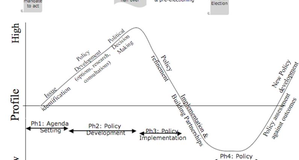Weight of Evidence Reporting: Pragmatic Optimism or a Bad Idea?
By
2015, Vol. 7 No. 10 | pg. 1/2 | » AbstractWhile some believe that scientists should communicate their research apolitically in research journals, others believe that scientists should communicate to the media in order to bring awareness to their research topic. As a compromise to these two views, Professor Sharon Dunwoody proposed "weight of evidence" reporting to bridge this gap between the objectivity of science and the subjectivity of the media. The goal of weight of evidence reporting is to create highly pragmatic media consumers that will be allowed to arrive at scientifically-sound, objective conclusions based upon data. However, it could be argued that weight of evidence reporting is simply too idealistic. On a controversial issue like global warming, prior research suggests that the American public’s reliance on partisan media contributes to this gap of understanding between science and the media. Thus, partisan media— the different ideological media outlets that compete for viewer attention—determine what is newsworthy, not scientific data alone. IntroductionFor many years, there has been a debate regarding the role of scientists in communicating their findings to the public at large. On the one hand, as Hmielowski et. al (2013) outline, "Scientists could remain on the sidelines and exclusively produce research for peer-reviewed journals and reports" (p. 879-880). On the other hand, there is also the idea that scientists should communicate their findings to the public and promote discussion. Scheufele (2014) explains, "…in most democratic societies, scientists have long played advisory roles to a variety of political entities. In those roles they have shaped policy and regulatory frameworks as members of advisory panels, through expert testimony and as political appointees…" (p. 13585). As a compromise to these two opposing views, Sharon Dunwoody of the University of Wisconsin-Madison proposed "weight of evidence" reporting to bridge the gap between the objectivity of science and the subjectivity of the media. Dunwoody (2005) defines weight of evidence reporting as a call for "… journalists not to determine what's true but, instead, to find out where the bulk of evidence and expert thought lies on the truth continuum and then communicate that to audiences" (p. 90). Simply put, scientists should state their views and reveal the scientific evidence supporting those views.
The goal of weight of evidence reporting, thus, is to create highly pragmatic media consumers that will be allowed to arrive at scientifically-sound, objective conclusions based upon data. In so doing, the bulk of scientific evidence would be the only criteria that would "tip" the scales of reporting urgency, instead of particular stories being selected to advance a particular partisan agenda. However, the objectivity of science and subjectivity of the media may not mix well to create informed media consumers. Instead, it could be argued that weight of evidence reporting is simply too idealistic. On a controversial issue like global warming, prior research suggests that the American public’s reliance on partisan media contributes to this gap of understanding between science and the media (Dunwoody, 2005, p. 89; Hiles & Hinnant, 2014, p. 429; Hmielowski et. al, 2013, p. 866). Partisan media— the different ideological media outlets that compete for viewer attention—determine what is newsworthy, not scientific data alone (McCombs & Shaw, 1972, p. 184). Since the media is just a slice of the fullness of reality, objectivity and balance—key tenets of science—are highly strategic in the media. As Dunwoody (2005) writes:
In so doing, journalists are more concerned about identifying and retaining an ideologically-sympathetic audience, regardless of whether scientific facts are used in their truth claims. Journalists may "translate" the scientific findings to "fit" in with their media outlet's partisan agenda, but they are often no experts themselves. With this in mind, weight of evidence does not work in practice because objective scientific data has to be marketed to a lay audience with sympathetic ideological persuasions. The Need for the MediaThe existence of the media is necessary, as it is impossible to experience every event going on throughout the world (Bosch, 2014, p. 217; McCombs & Shaw, 1972, p. 176). Audience members are what Hmielowski et. al (2013) refer to as "cognitive misers"—those who need shortcuts to find out which arguments are important to pay attention to (p. 870). Depending on our partisan ideology, we will select a media outlet (or group of outlets) that will highlight important world events that are ideologically-sympathetic to our views. When there is a highly controversial issue like global warming, the media is needed to ease this pressure to identify relevant arguments (Katz, Blumler, & Guervitch, 1973, p. 517). When an argument is constructed a particular way, the concept of "framing" is introduced. According to Entman (1993):
In addition, when framing is used, some facts will be emphasized over others—leading audience members to not get the full story on a given issue (Iyengar & Kinder, 1987, p. 63; Zillmann, 1999, p. 74). However, while the American public expects the journalist to simply identify and clarify the arguments, this is rarely the case because they insert their own biases into their stories (Dunwoody, 2005, p. 90). Many audience segments may simply be inactive; that is, they will believe everything a particular media outlet will tell them—without realizing that partisan media has an inherent agenda. However, for more active media consumers, they know ahead of time the type of partisan media outlets they will expose themselves to. They realize that, while the world is copied imperfectly by individual news media outlets, the fact that many audience segments share a composite definition of important stories strongly suggests that the mass media engages in agenda setting (McCombs & Shaw, 1972, p. 184). Likewise, the minds of active media consumers will also be "primed" to avoid any outlet or news story that violates their ideological expectations. Partisan media outlets may assume that the audience that they seek to attract are active media consumers. By believing that audiences segments need to get their beliefs confirmed, partisan media outlets realize that they are competing with other outlets that have similar or opposing interests (Katz, Blumler, & Gurevitch, 1973, pp. 510-511; Zillmann, 1988, p. 328). Likewise, partisan media outlets understand that they are not forcing their audience to consume their media; but rather, they are encouraging them to listen to their arguments by the vast number of arguments suggested (Denham, 2014, p. 18; Petty & Cacioppo, 1984, p. 69; Potter, 2009, p. 19). On the other hand, if a partisan media outlet assumes that their audience are inactive media consumers, they can present their opinions as fact. Politics, the Media, and Climate ChangeA key reason for why the ideological polarization exists between liberals and conservatives regarding climate change is that the media is obliged to show both sides of an issue to portray a sense of objectivity. This objectivity may not be necessary, as the majority of scientists believe that global warming is a very real phenomenon (Scheufele, 2014, p. 13588). Nonetheless, there is a relative lack of knowledge on the issue of climate change, which widens the gap between those who believe in the phenomenon and those who do not (Hmielowski et. al, 2013, p. 867; Horwitz, 2014; Kahan, Jenkins-Smith, & Braman, 2011, p. 147; NOAA National Climate Data Center, 2013; NOAA National Climate Data Center, 2014). While liberals will often trust scientists who believe in climate change, conservatives will undermine the phenomenon, as liberals call for increased government intervention (Hmielowski et. al, pp. 866-868). Conservatives may also harbor a general mistrust of the overwhelmingly liberal ideological balance between mainstream news outlets in the U.S. Between 2008-2010, there was a slight uptick in support for combating climate change among liberals, but a sharp decline among conservatives (Hmielowski et. al, 2013, p. 867; Jones, 2010). There are several reasons that could explain this dramatic shift among conservatives. The first would be the U.S. Economic Recession that lasted from 2008-2009, in which conservatives would want to be more careful about government spending that contributes to the national deficit. Secondly, Barack Obama was elected President of the U.S., and conservatives were often hard-pressed to find ideological consensus with the new incumbent. The third possible reason is the sharp uptick in social media use during that time (Hampton, Goulet, Rainie, & Purcell, 2011). Conservatives may feel that, since anyone can post on social media, they would have to be more careful online and would want to rely on more supported messages. Fitting Subjective Media into Objective ScienceThe best way to examine the seeming contradiction between the media and science is to compare the roles of each information transmitter: the journalist and the scientist. Journalists and scientists are very different, as Hiles & Hinnant (2014) explain, "… scientists view their work as technical, neutral, and apolitical, whereas journalists value individualism, creativity, and skepticism of authority—even of scientific findings" (p. 429). In some ways, journalists must be "ignorant" in order to appear balanced and non-biased in their news stories, but in reality, journalists influence scientific knowledge and policy-making by making reasoned arguments (Stocking & Holstein, 2009, pp. 23-25). Many of these arguments can be based the fact that scientists and journalists perceive risk differently (Kahan, Jenkins-Smith, & Braman, p. 148). Journalists appeal to the public by focusing on the present moment and the near future, which can affect the livelihoods of family, friends, and other important acquaintances. Many scientific findings emphasize the future beyond the present moment, as many scientists would want to give ample warning for changes that could be solved by human action. After all, the pace of the journalist's newsroom would dictate a quickened production of news stories—a far cry from the measured, steady pace of scientific experiments. While scientists may formulate the experiment and collect the data, journalists tie-in the findings as part of a larger partisan agenda (Hiles & Hinnant, 2014, p. 429; Kahan, Jenkins-Smith, & Braman, p. 148). However, scientists may not know how to "market" their data for a larger audience. The expertise of many scientists may not be in question, as they have dedicated their entire career to researching an issue or set of issues. On the contrary, a partisan journalists—as well as their audience—are likely no experts on a given field that a scientist studies. Nonetheless, the journalist will rely on the scientist for expert testimony, and the journalist will frame the scientist's expert opinion into an ideologically-sympathetic news story. Another way to view the liberal-conservative partisan spectrum would be through what Kahan, Jenkins-Smith, & Braman (2011) refer to as the "Cultural Cognition of Risk," which refers to the "…tendency of individuals to fit their perceptions of risk and related factual beliefs to their shared moral evaluations of putatively dangerous activities" (p. 148). Liberals, with their belief that government should play an active role in protecting the lives of citizenry, would view this cognition as an already-large entity that would play an increased role in protecting the environment. Conservatives, on the other hand, may completely reject the notion of climate change as a hoax perpetrated by liberals and the media. More moderate conservatives, however, may believe that climate change is happening, but would look to private industry to solve the problem. These moderate conservatives believe that the government is already entrenched too much into peoples' lives and that private industry—with its wealth of experience in tackling specialized environmental issues—would be better suited to solving the problem of climate change. Contrary to scientists, journalists are more concerned about finding and keeping an audience with thought-provoking stories. If weight of evidence reporting were to be implemented, it would face an uphill battle because there are three main reasons why partisan media is decreasing the coverage of science-related issues: there are fewer full-time science writers, research has shown that science seldom gets covered by the partisan media for the sake of science alone, and that the public increasingly turns to online sources—particularly search engines (Scheufele, 2014, p. 13588). The second reason is particularly important because it shows that there is a partisan agenda behind every news story that is published by an outlet, which would make it incredibly difficult for weight of evidence reporting to take root. The third reason has shown that the internet prioritizes different information for media consumers than the academic literature of scientists. Part of this reason lies in internet tracking because users who search for specific information on mainstream internet search engines will likely get customized results for similar information (Scheufele, 2014, p. 13588). When users can get customized results for future searches, this saves countless hours of research and allows users to get the information that they want and need quicker than ever before. It could also be argued that many academic journals are not adapting to this technology today, as they are not yet fully digital and thus cannot integrate their specialized results into mainstream search engines. Unlike scientists, journalists can often "translate" hard scientific data for readers, but these journalists are rarely experts in that particular field. This, of course, can lead to mistakes and misrepresentation—which a scientist can subsequently correct or clarify. Even if the arguments are factual, journalists must bend to the whims of their ideologically-biased editors. If partisan media portrays facts and arguments correctly, it can give the impression of a false consensus. According to Hiles & Hinnant (2014), there are two types of consensus: (1) creating the impression of a debate when there is none; and (2) glossing over important details to give the impression that there isn't a debate when there really is one (p. 429). Using this framework and applying it to climate change, liberals would use the scientific data provided by scientist to interpret that climate change is indeed happening and that the country needs government intervention to stop it from happening. Liberals would also say that there is a debate only as an attempt to discredit conservatives. While more moderate conservatives will believe that climate change solutions proposed by the government are inadequate, more traditionalist conservatives would engage in a "coordinated denial movement" perpetuated by the fossil fuels industry (Hiles & Hinnant, 2014, p. 429; Hmielowski et. al, 2013, p. 867; Lewandowsky, Gignac,, & Vaughn, 2012, p. 399; Stocking & Holstein, 2009, p. 23). Conservatives may not even acknowledge liberals' debate on climate change and may gloss over those details to show that climate change isn't happening. Subsequently, conservatives would utilize conservative think tanks to perform research, which would subsequently be passed on to conservative news outlets. Hmielowski et. al (2013) believe that the three reasons why journalists need to get expert testimony is because of: an issue's complexity, the issue being removed from everyday experience, and lack of knowledge on the subject (p. 870). However, ignorance and the lack of immediate media effects could be added as the fourth and fifth reasons (McCombs & Shaw, 1972, p. 176; McLeod & Reeves, 1981, p. 245; Rowe & Frewer, 2000, p. 5). The fifth reason is particularly important because it arises from the need to emphasize the point with facts that are correct and informed. When true facts can be taken from everyday life, reality according to a partisan agenda becomes much more easy to comprehend (Zillmann, 1999, p. 74). As Katz & Blumler (1973) emphasize, these facts offer "… impoverished real-life opportunities to satisfy certain needs, which are then directed to the mass media for complementary, supplementary, or substitute servicing" (p. 517). The media will often embark on a "man on the street" interview to convey the normality of public opinion and give the impression of consensus. According to Bosch (2014), there are three types: the highly-visible figure, someone with a personal connection to the story in question, and an ordinary person (p. 219-220). However, all of these sources are not "elite" enough to offer a pragmatic, informed, and expert opinion—which is where expert testimony comes in. However, the media has to be careful when taking into account expert interviews for sources, as self-proclaimed experts can be found in just about any field and may even disagree with one another (Hiles & Hinnant, 2014, p. 429; Hmielowski et. al, 2013, p. 866; Rowe & Frewer, 2000, p. 5). A journalist will still agree with experts that hold agreeable views and disagree with those experts who hold disagreeable views, thereby showing that partisanship still exists and subsequently creating a mental inventory of views that can be shaped (Kahan, Jenkins-Smith, & Braman, 2011, pp. 149-150). Regardless of the partisan affiliation, experts can strengthen one partisan view and, likewise, weaken another one.Continued on Next Page » Suggested Reading from Inquiries Journal
Inquiries Journal provides undergraduate and graduate students around the world a platform for the wide dissemination of academic work over a range of core disciplines. Representing the work of students from hundreds of institutions around the globe, Inquiries Journal's large database of academic articles is completely free. Learn more | Blog | Submit Latest in Business & Communications |


















